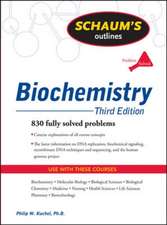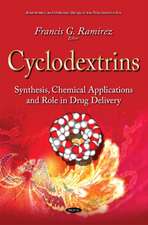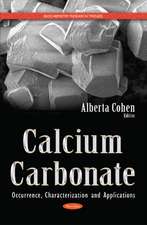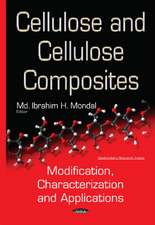Liposomes: Methods and Protocols, Volume 2: Biological Membrane Models: Methods in Molecular Biology, cartea 606
Editat de Volkmar Weissigen Limba Engleză Paperback – 6 apr 2012
| Toate formatele și edițiile | Preț | Express |
|---|---|---|
| Paperback (2) | 801.13 lei 6-8 săpt. | |
| Humana Press Inc. – 6 apr 2012 | 801.13 lei 6-8 săpt. | |
| Humana Press Inc. – 23 aug 2016 | 802.01 lei 6-8 săpt. | |
| Hardback (2) | 1124.95 lei 6-8 săpt. | |
| Humana Press Inc. – 23 dec 2009 | 1124.95 lei 6-8 săpt. | |
| Humana Press Inc. – 18 dec 2009 | 1125.88 lei 6-8 săpt. |
Din seria Methods in Molecular Biology
- 9%
 Preț: 791.59 lei
Preț: 791.59 lei - 23%
 Preț: 598.56 lei
Preț: 598.56 lei -
 Preț: 496.79 lei
Preț: 496.79 lei - 20%
 Preț: 882.95 lei
Preț: 882.95 lei -
 Preț: 252.04 lei
Preț: 252.04 lei - 5%
 Preț: 729.61 lei
Preț: 729.61 lei - 5%
 Preț: 731.43 lei
Preț: 731.43 lei - 5%
 Preț: 741.30 lei
Preț: 741.30 lei - 5%
 Preț: 747.16 lei
Preț: 747.16 lei - 15%
 Preț: 663.45 lei
Preț: 663.45 lei - 18%
 Preț: 1025.34 lei
Preț: 1025.34 lei - 5%
 Preț: 734.57 lei
Preț: 734.57 lei - 18%
 Preț: 914.20 lei
Preț: 914.20 lei - 15%
 Preț: 664.61 lei
Preț: 664.61 lei - 15%
 Preț: 654.12 lei
Preț: 654.12 lei - 18%
 Preț: 1414.74 lei
Preț: 1414.74 lei - 5%
 Preț: 742.60 lei
Preț: 742.60 lei - 20%
 Preț: 821.63 lei
Preț: 821.63 lei - 18%
 Preț: 972.30 lei
Preț: 972.30 lei - 15%
 Preț: 660.49 lei
Preț: 660.49 lei - 5%
 Preț: 738.41 lei
Preț: 738.41 lei - 18%
 Preț: 984.92 lei
Preț: 984.92 lei - 5%
 Preț: 733.29 lei
Preț: 733.29 lei -
 Preț: 392.58 lei
Preț: 392.58 lei - 5%
 Preț: 746.26 lei
Preț: 746.26 lei - 18%
 Preț: 962.66 lei
Preț: 962.66 lei - 23%
 Preț: 860.21 lei
Preț: 860.21 lei - 15%
 Preț: 652.64 lei
Preț: 652.64 lei - 5%
 Preț: 1055.50 lei
Preț: 1055.50 lei - 23%
 Preț: 883.85 lei
Preț: 883.85 lei -
 Preț: 792.16 lei
Preț: 792.16 lei -
 Preț: 423.62 lei
Preț: 423.62 lei - 5%
 Preț: 425.91 lei
Preț: 425.91 lei -
 Preț: 592.20 lei
Preț: 592.20 lei - 5%
 Preț: 345.62 lei
Preț: 345.62 lei - 19%
 Preț: 491.88 lei
Preț: 491.88 lei - 5%
 Preț: 1038.84 lei
Preț: 1038.84 lei - 5%
 Preț: 524.15 lei
Preț: 524.15 lei - 18%
 Preț: 2122.34 lei
Preț: 2122.34 lei - 5%
 Preț: 1299.23 lei
Preț: 1299.23 lei -
 Preț: 789.93 lei
Preț: 789.93 lei - 5%
 Preț: 1339.10 lei
Preț: 1339.10 lei - 18%
 Preț: 1390.26 lei
Preț: 1390.26 lei - 5%
 Preț: 752.66 lei
Preț: 752.66 lei - 5%
 Preț: 374.89 lei
Preț: 374.89 lei - 18%
 Preț: 1395.63 lei
Preț: 1395.63 lei - 18%
 Preț: 1129.65 lei
Preț: 1129.65 lei - 18%
 Preț: 1408.26 lei
Preț: 1408.26 lei - 18%
 Preț: 1124.92 lei
Preț: 1124.92 lei - 18%
 Preț: 966.27 lei
Preț: 966.27 lei
Preț: 801.13 lei
Preț vechi: 843.30 lei
-5% Nou
Puncte Express: 1202
Preț estimativ în valută:
153.32€ • 158.17$ • 129.76£
153.32€ • 158.17$ • 129.76£
Carte tipărită la comandă
Livrare economică 05-19 martie
Preluare comenzi: 021 569.72.76
Specificații
ISBN-13: 9781617796876
ISBN-10: 1617796875
Pagini: 564
Ilustrații: XVI, 548 p. 126 illus., 7 illus. in color.
Dimensiuni: 178 x 254 x 30 mm
Greutate: 0.97 kg
Ediția:2010
Editura: Humana Press Inc.
Colecția Humana
Seria Methods in Molecular Biology
Locul publicării:Totowa, NJ, United States
ISBN-10: 1617796875
Pagini: 564
Ilustrații: XVI, 548 p. 126 illus., 7 illus. in color.
Dimensiuni: 178 x 254 x 30 mm
Greutate: 0.97 kg
Ediția:2010
Editura: Humana Press Inc.
Colecția Humana
Seria Methods in Molecular Biology
Locul publicării:Totowa, NJ, United States
Public țintă
Professional/practitionerCuprins
Utilization of Liposomes for Studying Drug Transfer and Uptake.- The Use of Liposomes in the Study of Drug Metabolism: A Method to Incorporate the Enzymes of the Cytochrome P450 Monooxygenase System into Phospholipid, Bilayer Vesicles.- Use of Liposomes to Study Cellular Osmosensors.- Studying Mechanosensitive Ion Channels Using Liposomes.- Studying Amino Acid Transport Using Liposomes.- Use of Liposomes for Studying Interactions of Soluble Proteins with Cellular Membranes.- Liposomal Reconstitution of Monotopic Integral Membrane Proteins.- The Reconstitution of Actin Polymerization on Liposomes.- Electroformation of Giant Unilamellar Vesicles from Native Membranes and Organic Lipid Mixtures for the Study of Lipid Domains under Physiological Ionic-Strength Conditions.- Visualization of Lipid Domain-Specific Protein Sorting in Giant Unilamellar Vesicles.- Biosynthesis of Proteins Inside Liposomes.- Study of Respiratory Cytochromes in Liposomes.- Use of Liposomes to Evaluate the Role of Membrane Interactions on Antioxidant Activity.- Studying Colloidal Aggregation Using Liposomes.- Assessment of Liposome–Cell Interactions.- Methods to Monitor Liposome Fusion, Permeability, and Interaction with Cells.- The Use of Isothermal Titration Calorimetry to Study Multidrug Transport Proteins in Liposomes.- Studying Lipid Organization in Biological Membranes Using Liposomes and EPR Spin Labeling.- Membrane Translocation Assayed by Fluorescence Spectroscopy.- Interaction of Lipids and Ligands with Nicotinic Acetylcholine Receptor Vesicles Assessed by Electron Paramagnetic Resonance Spectroscopy.- Environmental Scanning Electron Microscope Imaging of Vesicle Systems.- Freeze-Fracture Electron Microscopy on Domains in Lipid Mono- and Bilayer on Nano-Resolution Scale.- Atomic ForceMicroscopy for the Characterization of Proteoliposomes.- Method of Simultaneous Analysis of Liposome Components Using HPTLC/FID.- Viscometric Analysis of DNA-Lipid Complexes.- Fluorometric Analysis of Individual Cationic Lipid-DNA Complexes.- Fluorescence Resonance Energy Transfer-Based Analysis of Lipoplexes.- Analysis of Lipoplex Structure and Lipid Phase Changes.- Fluorescence Methods for Evaluating Lipoplex-Mediated Gene Delivery.- FRET Imaging of Cells Transfected with siRNA/Liposome Complexes.- Spectral Bio-Imaging and Confocal Imaging of the Intracellular Distribution of Lipoplexes.- Techniques for Loading Technetium-99m and Rhenium-186/188 Radionuclides into Pre-formed Liposomes for Diagnostic Imaging and Radionuclide Therapy.- Fluorescence Correlation Spectroscopy for the Study of Membrane Dynamics and Organization in Giant Unilamellar Vesicles.- Liposome Biodistribution via Europium Complexes.- Biosensor-Based Evaluation of Liposomal Binding Behavior.- Use of Liposomes to Study Vesicular Transport.
Recenzii
From the reviews:
“Provide a comprehensive guide to the preparation, characterisation, and potential use of currently known types of liposomes. They are written using an interdisciplinary approach, and so provide essential knowledge of liposomes, for not only researchers in this particular field, but also scientists in wider pharmaceutical and biological areas. … very inspiring – the potential for liposomes is immense – and these well-written chapters ignited notions of further applications – this is clearly a very exciting field.” (Trudy L. Knight, BTS Newsletter, Issue 37, Winter, 2010)
“Provide a comprehensive guide to the preparation, characterisation, and potential use of currently known types of liposomes. They are written using an interdisciplinary approach, and so provide essential knowledge of liposomes, for not only researchers in this particular field, but also scientists in wider pharmaceutical and biological areas. … very inspiring – the potential for liposomes is immense – and these well-written chapters ignited notions of further applications – this is clearly a very exciting field.” (Trudy L. Knight, BTS Newsletter, Issue 37, Winter, 2010)
Textul de pe ultima copertă
With nearly one hundred years of intensive study, lipids have proven to be a vital and ever-more-promising area of cell biological research. In Liposomes: Methods and Protocols, leading experts in the related fields explore cutting-edge experimental methods involving all aspects of lipids as essential components of the cell membrane. Volume 2: Biological Membrane Models focuses on detailed methods for the use of liposomes in studying a variety of biochemical and biophysical membrane phenomena concomitant with chapters describing a great palette of state-of-the-art analytical technologies. As a volume in the highly successful Methods in Molecular Biology™ series, the chapters include introductions to their respective topics, lists of the necessary materials and reagents, step-by-step, readily reproducible laboratory protocols, and notes on troubleshooting and avoiding known pitfalls.
Comprehensive and authoritative, Liposomes: Methods and Protocols promises to be an essential source of practical know-how for every investigator, young and seasoned alike, whose research area involves in one way or another phospholipids, glycolipids, or cholesterol.
Comprehensive and authoritative, Liposomes: Methods and Protocols promises to be an essential source of practical know-how for every investigator, young and seasoned alike, whose research area involves in one way or another phospholipids, glycolipids, or cholesterol.
Caracteristici
Volume 2 specifically: Provides an essential and comprehensive source for every investigator whose research involves any one aspect of lipids as essential components of biological membranes Serves as a comprehensive compilation of cutting-edge methodologies centered around lipids as the essential components of biological membranes With two volumes totaling 72 chapters, presents the first ever published comprehensive reference for the application of liposomes as pharmaceutical nanoscale drug delivery systems and as models for biological membranes Provides in a very comprehensive way detailed guidance for the utilization of liposomes in Pharmacy, Chemistry, Biochemistry, Biophysics, and Molecular Biology Offers a truly interdisciplinary approach to make the versatile features of liposomes accessible to a very wide range of investigators in Academia and Industry Acts as a comprehensive guide to preparing, purifying, and physico-chemically characterizing all currently known types of liposomes Includes supplementary material: sn.pub/extras














